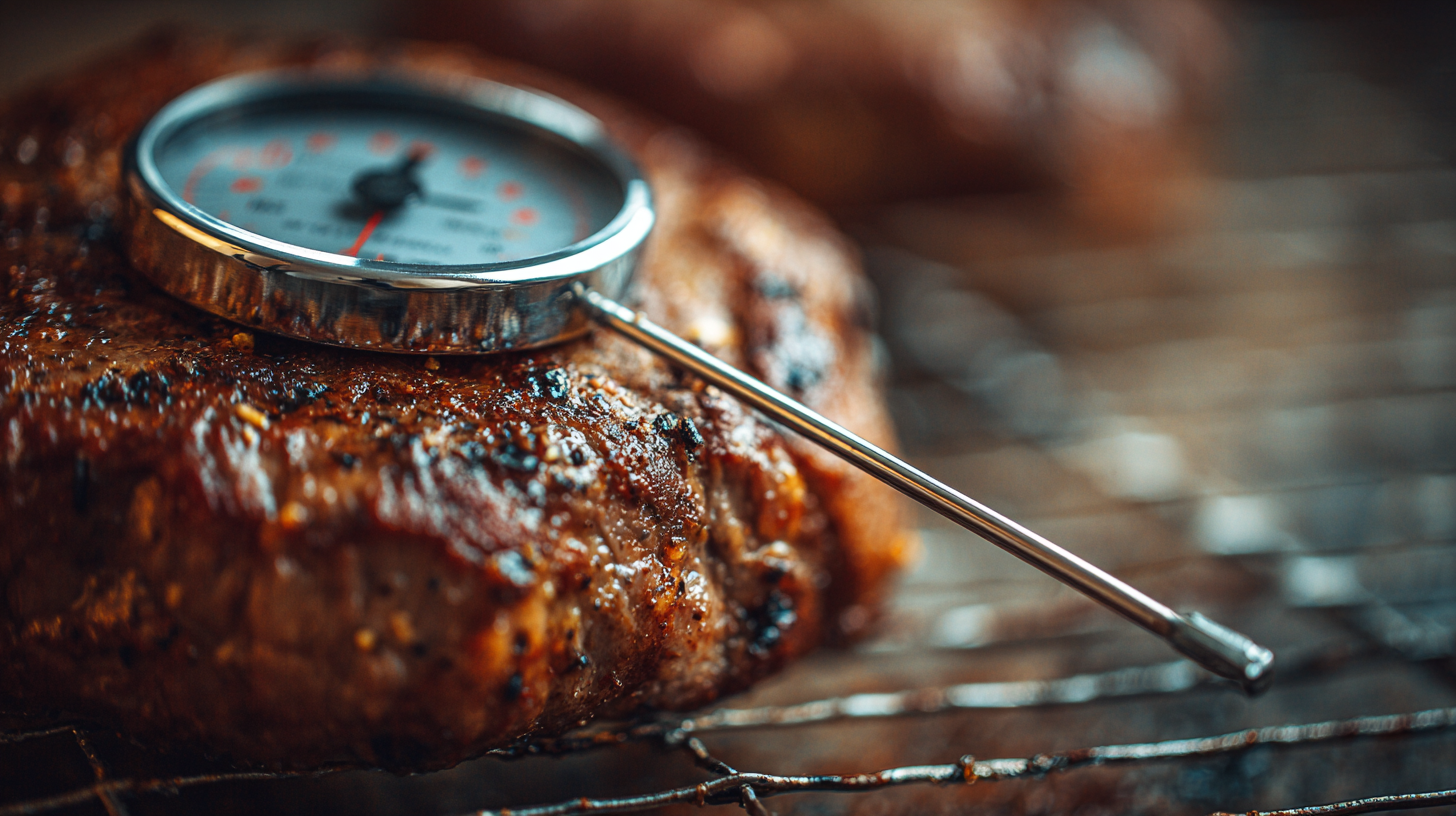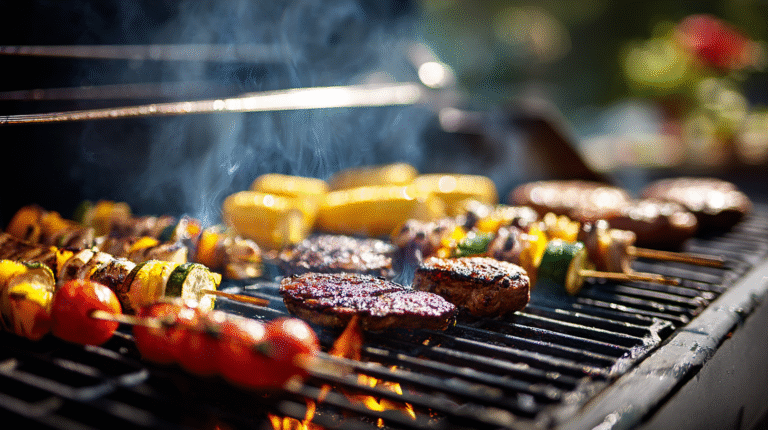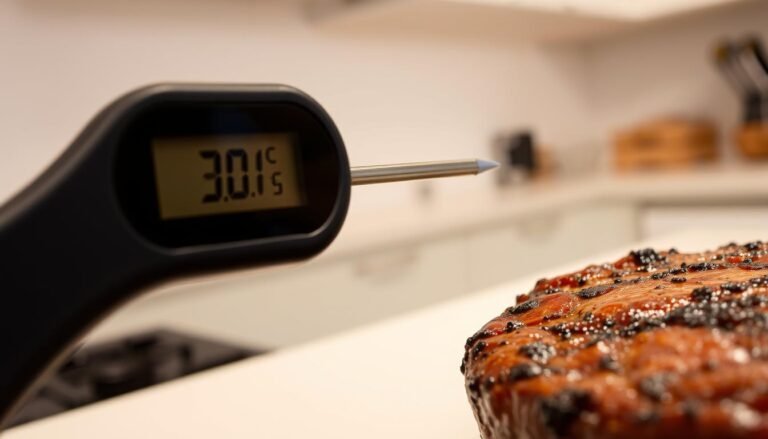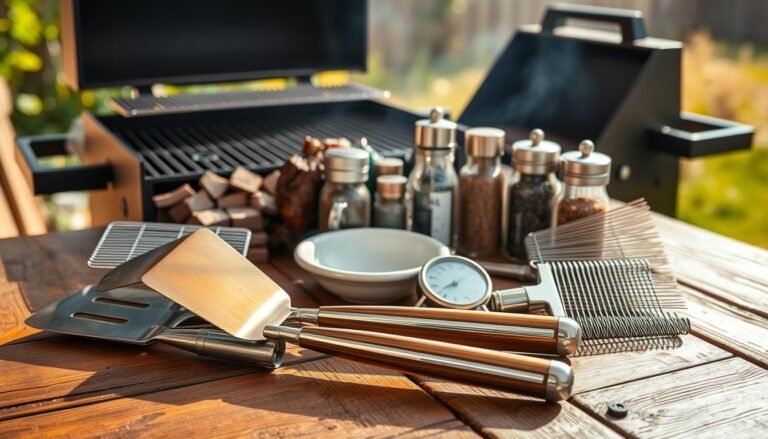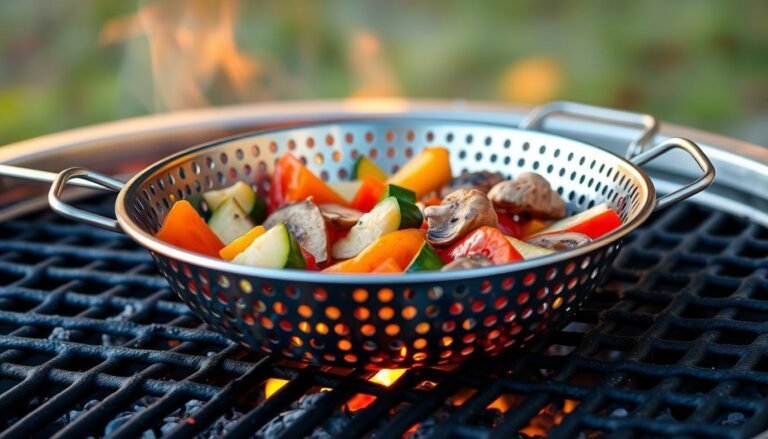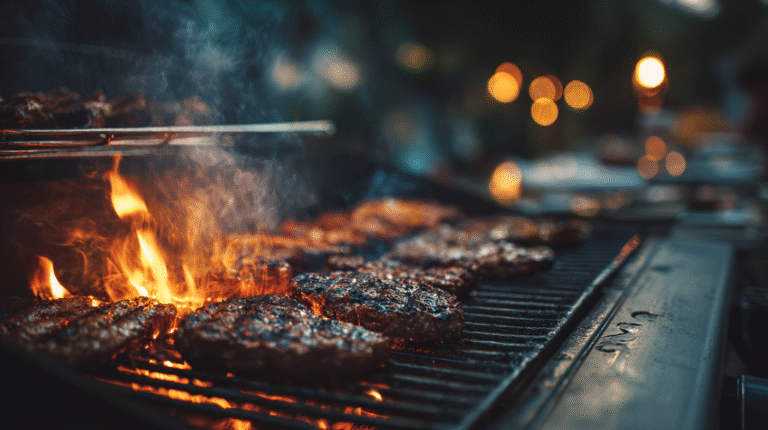Disclosure: This Post Contains Affiliate Links; We earn a commission on purchases.
Grilling is a favorite way to cook, perfect for summer. But, getting meat just right can be tricky. A meat thermometer is key for safe and juicy meat. It takes the guesswork out of cooking.
A thermometer ensures your meat is cooked safely. This stops foodborne illnesses. It also makes your meat tender and juicy, making grilling a success every time.
Key Takeaways
- Ensures food safety by cooking meat to a safe internal temperature.
- Prevents undercooking or overcooking, resulting in juicy meat.
- Eliminates guesswork, making grilling easier.
- Helps achieve tender and perfectly cooked meat.
- Essential for a successful grilling experience.
The Hidden Dangers of Improperly Cooked Meat
Improperly cooked meat can be very dangerous. Grilling is popular, but it’s hard to get it right. The dangers of undercooked meat are a big worry for those who love grilled food.
Common Foodborne Illnesses from Undercooked Meat
Undercooked meat can have harmful bacteria like Salmonella and E. coli. These can cause serious sickness. Symptoms include diarrhea, stomach pain, and even life-threatening issues. A digital meat thermometer helps make sure your meat is safe to eat.
Why Visual Cues Are Unreliable for Determining Doneness
Looking at meat to see if it’s cooked is not a good idea. Meat can look done on the outside but not inside. This is true for thicker cuts. To be sure, use a best meat thermometer to check the meat’s temperature.
Knowing the dangers of undercooked meat and using the right tools makes grilled meals safe and tasty.
How a Meat Thermometer Ensures Food Safety
Keeping food safe while grilling is key. A meat thermometer is essential for this. It gives an accurate internal temperature, preventing undercooked or overcooked meat. This reduces the chance of getting sick from food.
USDA Recommended Internal Temperatures for Different Meats
The USDA has guidelines for safe meat temperatures. For example:
- Beef, pork, lamb, and veal steaks, roasts, and chops need to be at least 145°F (63°C).
- Ground meats, like ground beef, pork, lamb, and veal, should be cooked to 160°F (71°C).
- Poultry, including chicken and turkey, must be cooked to 165°F (74°C).
Using a wireless meat thermometer or an instant read meat thermometer ensures these temperatures. For more on safe grilling, check out Quick Simple Grilling.
Eliminating Guesswork from Your Cooking Process
There’s no room for guessing in safe cooking. A meat thermometer removes the guesswork. With a wireless meat thermometer, you can check meat temperature from afar. This means your meat is always cooked just right, without needing to watch it all the time.
Using a meat thermometer means safe food and perfectly cooked meat every time. It’s great for both experienced grillers and beginners. Adding a meat thermometer to your grilling routine makes a big difference.
The Secret to Juicy, Perfectly Cooked Meat Every Time
The secret to juicy, perfectly cooked meat is knowing the right internal temperatures. You need the right techniques and tools, like a good meat thermometer.
Understanding Temperature Ranges for Different Levels of Doneness
Cooking meat to the right temperature is key for the perfect doneness. A Bluetooth meat thermometer lets you check the meat’s temperature from afar. It ensures it hits the mark. Different meats have their own ideal temperatures, like 145°F for medium-rare beef and 165°F for fully cooked poultry.
Preventing Overcooking and Dry Meat
Overcooking and dry meat often come from cooking too long. A precise thermometer helps by giving you updates on the meat’s temperature. This way, you can take it off the heat just when it’s right, keeping it juicy.
Achieving Restaurant-Quality Results at Home
To get restaurant-quality meat at home, get a probe meat thermometer. It lets you keep an eye on the meat’s temperature all the time. For more tips on cooking perfect meat, check out Orka Tech’s guide.
Types of Meat Thermometers for Every Cooking Style
Meat thermometers come in many styles. Each is made for different cooking needs. Whether you grill casually or are a serious pitmaster, there’s a thermometer for you.
Digital vs. Analog Meat Thermometers
Digital thermometers give quick and precise readings. They’re great for those who want accuracy and ease. Analog thermometers are cheaper and don’t need batteries. But, they might not be as precise as digital ones.
Instant Read Meat Thermometers for Quick Temperature Checks
Instant read thermometers give fast and accurate readings. They’re perfect for checking meat doneness quickly. They’re great for cooks who need to check temperatures fast.
Wireless and Bluetooth Meat Thermometers for Convenient Monitoring
Wireless and Bluetooth thermometers let you monitor meat temperature from afar. This is great for multitasking cooks. You can watch your grill or oven without being right next to it.
Probe and Remote Meat Thermometers for Continuous Temperature Tracking
Probe and remote thermometers track temperature continuously. They ensure meat is cooked safely. They’re best for large or thick cuts of meat.
Single Probe vs. Multi-Probe Options
Probe thermometers come in single or multi-probe models. Single probes are good for one or two items. Multi-probes let you track multiple meats at once. They’re perfect for big gatherings or complex meals.
Choosing the right meat thermometer depends on your cooking needs and preferences. Think about what you cook most and what features matter to you. This way, you’ll find the perfect thermometer for perfectly cooked meat.
How to Choose the Right Meat Thermometer for Your Needs
Finding the perfect meat thermometer can be tough. There are many types for different cooking needs. It’s key to know what each offers.
Key Features to Look for in an Accurate Meat Thermometer
Accuracy is the top priority. Look for thermometers with precise sensors for quick, reliable readings. Also, consider ease of use, durability, and fast response time. A good thermometer should be easy to calibrate and keep up.
Budget-Friendly vs. Premium Options
Thermometers range from under $10 to over $100. Basic ones are cheap but premium thermometers have cool features like wireless and high-resolution displays. Think about how often you cook and what you need.
Best Meat Thermometers for Different Cooking Methods
Each cooking method needs a special thermometer. For grilling and smoking, look for ones that handle high heat and can be monitored from afar. For oven roasting, a long probe and high accuracy are best. Know your main cooking method to pick the right one.
Conclusion: Elevate Your Grilling Game with a Reliable Meat Thermometer
A good Meat Thermometer is key for perfect meat every time. It makes sure your food is safe and your grilling gets better. You can pick from many types, like digital meat thermometer, wireless meat thermometer, or instant read meat thermometer.
Choosing a Bluetooth meat thermometer or probe meat thermometer lets you track temperatures all the time. This way, your meat will always be cooked right. There are many options, including remote meat thermometer and best meat thermometer models, to fit your needs and budget.
Adding a meat thermometer to your grilling makes your food taste like it’s from a restaurant. So, upgrade your grilling with a reliable meat thermometer today.
FAQ
What is the most accurate type of meat thermometer?
How do I use a wireless meat thermometer?
What is the recommended internal temperature for cooking different types of meat?
Can I use a meat thermometer for other types of cooking, like smoking or braising?
How do I choose the best meat thermometer for my needs?
Are Bluetooth meat thermometers reliable?
Can I leave a probe thermometer in the meat while it’s cooking?
How do I calibrate my meat thermometer?

From quick grilling techniques to simple gear advice, Ryan helps beginners and busy home cooks fire up great meals without over-complicating it. Whether you’re using charcoal, gas, or a portable grill, Ryan’s goal is to make grilling approachable, fun, and full of flavor.
Subscribe to Our Newsletter

